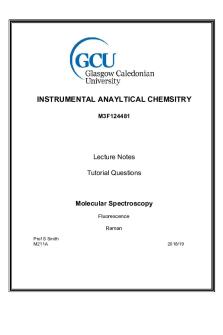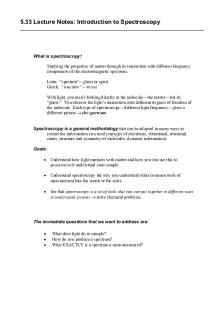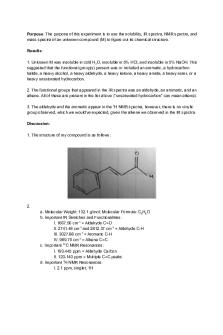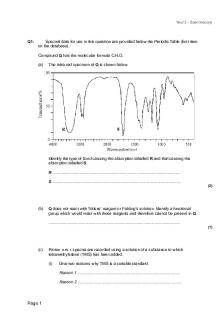Spectroscopy Lecture Notes PDF

| Title | Spectroscopy Lecture Notes |
|---|---|
| Course | Instrumental Analytical Chemistry |
| Institution | Glasgow Caledonian University |
| Pages | 52 |
| File Size | 2.1 MB |
| File Type | |
| Total Downloads | 85 |
| Total Views | 141 |
Summary
All lecture material on the topic of Spectroscopy....
Description
INSTRUMENTAL ANAYLTICAL CHEMSITRY M3F124481
Lecture Notes Tutorial Questions
Molecular Spectroscopy Fluorescence Raman Prof S Smith M211A
2018/19
2
Table of Contents
Luminescence .................................................................................................................... 5 Photoluminescence ......................................................................................................... 5 Excited States .................................................................................................................. 7 Fluorescence ................................................................................................................... 8 Frank-Condon Principle .............................................................................................. 9 Mirror Image Rule: ................................................................................................... 10 Stokes Shift: .............................................................................................................. 11 Quantum Yield .......................................................................................................... 11 Fluorescence and Concentration ............................................................................... 12 Fluorescence and Molecular Structure...................................................................... 13 Effects of substitution on quantum yield. ................................................................. 14 Rate Constants .......................................................................................................... 14 Fluorescence Lifetime ............................................................................................... 15 Instruments used in Fluorescence Spectroscopy .......................................................... 17 Spectrofluorimeter ........................................................................................................ 17 Emission Spectrum ................................................................................................... 17 Excitation Spectrum .................................................................................................. 17 Excitation at different wavelengths .......................................................................... 18 Synchronous Scan ..................................................................................................... 18 Measuring Fluorescence Lifetimes ........................................................................... 19 Fluorophore Interactions ............................................................................................... 21 Solvent Effects .......................................................................................................... 21 Excimer Formation ................................................................................................... 23 Fluorescence Quenching ........................................................................................... 24 Fluorescence Resonance Energy Transfer (FRET)................................................... 25 Fluorescence in Forensic Applications .......................................................................... 26 Natural Fluorophores .................................................................................................... 26 DNA Labelling.......................................................................................................... 26 Detection of Blood .................................................................................................... 27 Fingerprint detection ................................................................................................. 28 Drug Detection .......................................................................................................... 28 Raman Spectroscopy ...................................................................................................... 29 Raman Activity – Polarisability Changes ..................................................................... 29 Energy Level Diagram .................................................................................................. 30 Raman Spectrum for CCl4 ............................................................................................ 30 The Raman Equation: ................................................................................................... 31 Raman Theory ............................................................................................................... 31 Polarisability Ellipsoid .................................................................................................. 32 Raman selection rules: .................................................................................................. 33 Raman Spectra .............................................................................................................. 34 Hydrogen................................................................................................................... 34 Diatomic Molecules .................................................................................................. 34 Carbon Dioxide ......................................................................................................... 34 Asymmetric Toped Molecules .................................................................................. 36 Linear Molecule ........................................................................................................ 37 3
Spherical Topped Molecules..................................................................................... 37 Raman Depolarisation Ratios ................................................................................... 38 Resonance Raman Scattering ........................................................................................ 40 Raman Spectrometers .................................................................................................... 41 Dispersive Raman Layout ......................................................................................... 41 Raman Microscope ................................................................................................... 43 FT-Raman ................................................................................................................. 43 Advantages of Raman Spectroscopy ............................................................................ 44 Forensic Applications ..................................................................................................... 45 Tutorial Questions .......................................................................................................... 46 Fluorescence ................................................................................................................. 46 Raman Spectroscopy ..................................................................................................... 49
4
Luminescence Luminescence is defined as the emission of light by a substance. This phenomenon occurs when a molecule in the excited state returns to the ground state with the emission of a photon. The electron can be promoted to the excited state by a number of different means: Photoluminescence:
Electroluminescence:
Chemiluminescence:
Bioluminescence:
Photoluminescence Luminescence which results from the absorption of a photon from the ground state to a higher excited state can be subdivided into fluorescence which occurs due to deexcitation from the 1st excited singlet state and phosphorescence which results due to de-excitation from the triplet state (see Jablonski diagram below).
S2
2 1 0
S1
2 1 0
T1
Absorption So
Vibrational Relaxation
Fluorescence
2 1 0
Jablonski Diagram So, S1, S2 and T1 – electronic states So - ground state S1 -first excited singlet state S2 – second excited state T1 - triplet state.
5
Also shown are vibrational energy levels in the 3 electronic states. Processes occurring: Absorption A photon of an appropriate energy (E = h f) is absorbed by the molecule, resulting in an electron making the transition from the So state to the S1 state (or a higher electronic state). Transitions to the various vibrational energy levels in the excited state give rise to the structure in the absorption spectrum. The timescale for this process is ~ 10-12 s This process can be described as follows: So + hfa → S1 Fluorescence Fluorescence is the emission of a photon when an electron makes a transition from the lowest vibrational level in the S1 state back down to the ground state. Fluorescence is discussed in more detail below and can be represented by: S1 → So + hfe + heat Phosphorescence Phosphorescence is the emission of a photon when an electron makes a transition from the lowest vibrational level in the T1 state down to the So state. This is spin forbidden transition and occurs in the millisecond to second time scale. T1 → So + hf p + heat Vibrational Relaxation (dashed line) This is where energy is lost due to non-radiative transitions, i.e. the energy is dissipated as heat in the lattice. Vibrational relaxation can occur between vibrational energy levels or between electronic states. Intersystem Crossing Intersystem crossing is when an electron changes spin with no loss of energy. This results in the electron crossing from the singlet to the triplet manifold. Intersystem crossing is facilitated by either heavy atoms or nonbonding electrons. If the electron then crosses back into the singlet state and this is then followed by a fluorescence emission albeit at a much longer timescale. This process is termed delayed fluorescence. Internal Conversion This occurs when an electron moves between different electronic singlet states with no loss of energy.
6
Excited States The main difference between the singlet and triplet excited state is electron spin. The Pauli Exclusion Principle states that 2 electrons in an atom cannot have the same four quantum numbers and only 2 electrons can occupy each orbital where they must have opposite spin states. This is called spin pairing. Singlet State: All electron spins are paired in the molecular electronic excited state and the electronic energy levels do not split when the molecule is exposed to a magnetic field. A singlet or a triplet can form when an electron is promoted to a higher energy level. Excited Singlet State: Electron is promoted in the same spin orientation as it was in the ground state (paired). Excited Triplet State: The promoted electron has a spin direction that is the same as the electron in the ground state.
Gro und Sing let Stat e
Excit ed Si ng let St at e
Excit ed Triplet State
Singlet and triplet is derived from the equation for multiplicity: 2S+1, where S is the total spin angular momentum. Spin up is denoted as s = + ½ and spin down as s = - ½ . So for the singlet state: multiplicity is 2(+ ½ + - ½ )+1 = 2 (0) +1 = 1 Triplet state multiplicity is 2(+ ½ + +½ )+1 = 2 + 1 = 3
Hence the transition from a singlet to triplet state (or vice versa) involves a change in electron state and hence has a low probability of occurring, thus leading to transitions that are less intense and occur over a longer time frame.
7
Fluorescence Fluorescence involves two independent processes, absorption and fluorescence, hence giving rise to both an excitation and emission spectrum. The fluorescence spectrum appears at longer wavelengths because energy is lost in the excited state by nonradiative vibrational relaxation.
Quinine BiSulfate in 0.05 M H2SO4 6000
2.E+06
Extinction Coefficient
2.E+06 1.E+06
4000
1.E+06 3000
1.E+06 8.E+05
2000
6.E+05 4.E+05
1000
Fluorescence Intensity
2.E+06 5000
2.E+05 0
0.E+00 270
320
370 420 470 Wavelength (nm) Absorbance
520
570
Fluorescence
In order to observe a fluorescence spectrum, then an excitation wavelength should be selected which falls within the absorption spectrum. Ideally, this would be the peak absorption wavelength, but for molecules which have a large overlap between the absorption and emission spectrum then you may opt to excite the sample at a lower wavelength. To obtain the fluorescence spectrum of Quinine Bisulfate (see figure above) the excitation wavelength selected is 345 nm. In fluorescence, the species remains in the excited state for a very short time with typical fluorescence lifetimes of 1-20ns (c.f. phosphorescence where the lifetimes are much longer - typically 1 µs to 10s). Molecules which fluoresce have rigid, planar structures that lessen competing non radiative transitions. The only class of organic substances that fluoresce reasonably efficiently are aromatic and aliphatic molecules with extensive π - electron systems (alternating single & double bonds). Both types have low-lying excited π* singlet states. The most common electronic transition is π π*. Fluorophores can be split into two groups, natural or intrinsic fluorophores (e.g. proteins, nucleic acids) and extrinsic fluorophores.
8
Frank-Condon Principle The Frank-Condon principle states that all electronic transitions are vertical i.e. they occur without any change in the position of the nuclei in the molecular entity and its environment. The resulting state is known as a Frank-Condon state. There are however many exceptions to this rule which are generally due to different electronic structures in the excited or ground state depending on which spectra is devoid of structure. Also, excited state reactions may play a role in this.
The spectra of some compounds, such as perylene, show significant structure in their spectra due to the individual vibrational energy levels of the ground and excited states.
9
Mirror Image Rule: For planar rigid structures, such as perylene, the emission spectrum is a mirror image of the absorption spectrum.
1.E+07
40000
9.E+06
35000
8.E+06 7.E+06
30000
6.E+06
25000
5.E+06 20000
4.E+06
15000
3.E+06
10000
2.E+06
5000
1.E+06
0
Fluorescence Intensity
Extinction Coefficient (M-1 cm -1 )
Perylene in cyclohexane 45000
0.E+00 300
350
400
450
500
550
600
Wavelength (nm) Absorbance
Fluorescence
Beware there are MANY exceptions to this rule, for example –p-terphenyl:
3.00E+06 2.50E+06 2.00E+06
25000 20000
1.50E+06
15000
1.00E+06
10000 5.00E+05 5000 0 230
0.00E+00 280
330
380
430
Wavelength (nm) Absorption Spectrum
Fluoresc ence Spectrum
Reason:
10
Intensity
-1
30000
Extinction Coefficient (M cm )
35000
-1
40000
Stokes Shift: Fluorescence always occurs at lower energy than absorption. The shift in wavelength between the 0-0 transitions in the absorption and fluorescence spectra is known as Stokes Shift. For highly fluorescent molecules such as perylene Stokes shift is typically 1-2nm.
Quantum Yield The quantum yield, φf, of the fluorescence emission is the ratio of absorbed photons to the number of emitted photons and is characteristic for each species. This quantity is always less than unity due to Stokes losses.
φ f=
No. of fluorescence photons No. of absorbed photons
The quantum yield gives an upper limit on the sensitivity of the measurement. increases with no. of rings and degree of condensation.
φF
The fluorescence intensity emitted by a sample is given by Parker’s law
Ifl = 2.3 k Iex φf ε 1 c where Iex is the excitation intensity, φf is the fluorescence quantum efficiency, ε is the extinction coefficient at λex, l is the path length, c is the concentration of the fluorescent species and k is a factor to take into account that only a fraction of the total emission is measured.
11
Fluorescence and Concentration
Example A shows the case for a dilute sample concentration (A < 0.05). Most of the blue excitation beam passes through without being absorbed. The instrument measures the part of the sample where the excitation and emission beams overlap. In this case the fluorescence intensity is given by Parker’s law In example B, the excitation light is totally absorbed within the pathlength of the cuvette. In this case, some of the sample molecules located in the darker region of the measured volume are not measured-they do not fluoresce since there is no light to be absorbed. In severe cases (case C), the excitation light is absorbed within the first millimetre or so of the light path. Virtually no light reaches the measured part of the cuvette, so the measured fluorescence intensity is very low or even zero.
12
Fluorescence and Molecular Structure Most unsubstituted aromatic hydrocarbons fluoresce in solution. The φF increases with number of rings and degree of condensation. Fluorescence is more commonly associated with compounds in which the lowest energy transition is of π → π*, i.e. the quantum efficiency is greater. Also the molar absorptivity for π → π* transitions are 100- to 1000-times greater than for n → π* Fluorescence Lifetime for π → π* is shorter. Thermodynamic considerations suggest that rate constant for intersystem crossing is smaller for π → π*
Simple heterocyclics do not exhibit fluorescence:
H N
Pyridine
O
S
N
Furan
Thiopene
Pyrrole
But fused-ring structures ordinarily do:
H N
N
Quinoline
Indole
Fluorescence is particularly favoured in molecules which have some structural rigidity:
C H2 Fluorene
Biphenyl
φf
φf ~
~ 1.0
13
0.2
Effects of substitution on quantum yield. Electron withdrawing groups e.g. carbonyl, nitro, halogens will decrease fluorescence, while electron donating groups, e.g. amino, hydroxy enhance fluorescence as valence electrons can be donated to the ring system.
Rate Constants
Rate constant
Equation
Process Absorption
ka
Vibrational relaxation
kvr
Internal conversion
kic
Fluorescence emission
kf
Intersystem crossing
kisc
Phosphorescence emission
kp
Collisional quenching
kQ
The rate equation is given as:
dn S1 dt
= k an So − (k r + k nr )n S1
where kr represents all the radiative processes and knr all the non-radiative processes. i.e. kr = kf and knr = kvr + kic + kisc + kQ. When the sample is illuminated with photons of constant intensity, a steady-state concentration of S1 is quickly achieved. In other words
14
dn S1 dt
= 0 and
nS1 =
nSo ka kf + knr
Substitution for the photon flux and rear...
Similar Free PDFs

Spectroscopy Lecture Notes
- 52 Pages

Spectroscopy
- 5 Pages

Mass Spectroscopy
- 14 Pages

Spectroscopy Lab
- 2 Pages

Raman Spectroscopy
- 22 Pages

Spectroscopy Questions
- 116 Pages

Infrared Spectroscopy
- 3 Pages

Spectroscopy+EC 0002a
- 1 Pages

Introduction to Spectroscopy 1
- 3 Pages

Atomic Absorption Spectroscopy
- 271 Pages

Spectroscopy exercises SL
- 6 Pages

Topic 4 :Spectroscopy -Exercises
- 2 Pages

Atomic Absorption Spectroscopy
- 9 Pages
Popular Institutions
- Tinajero National High School - Annex
- Politeknik Caltex Riau
- Yokohama City University
- SGT University
- University of Al-Qadisiyah
- Divine Word College of Vigan
- Techniek College Rotterdam
- Universidade de Santiago
- Universiti Teknologi MARA Cawangan Johor Kampus Pasir Gudang
- Poltekkes Kemenkes Yogyakarta
- Baguio City National High School
- Colegio san marcos
- preparatoria uno
- Centro de Bachillerato Tecnológico Industrial y de Servicios No. 107
- Dalian Maritime University
- Quang Trung Secondary School
- Colegio Tecnológico en Informática
- Corporación Regional de Educación Superior
- Grupo CEDVA
- Dar Al Uloom University
- Centro de Estudios Preuniversitarios de la Universidad Nacional de Ingeniería
- 上智大学
- Aakash International School, Nuna Majara
- San Felipe Neri Catholic School
- Kang Chiao International School - New Taipei City
- Misamis Occidental National High School
- Institución Educativa Escuela Normal Juan Ladrilleros
- Kolehiyo ng Pantukan
- Batanes State College
- Instituto Continental
- Sekolah Menengah Kejuruan Kesehatan Kaltara (Tarakan)
- Colegio de La Inmaculada Concepcion - Cebu


